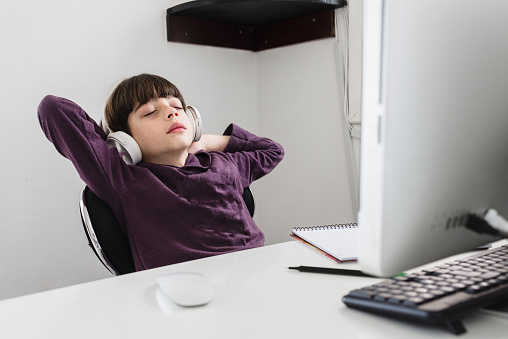With many children engaged in four or more hours of online learning each day due to the COVID-19 pandemic, screen fatigue is a big concern for parents and educators.
For all people, online interactions via Zoom and other video platforms require extra effort to communicate. It takes additional work to hear, understand, speak and stay focused online than it does through in-person exchanges.
Although all children are susceptible to screen fatigue, those with communication disorders may have an especially difficult time adapting to and thriving within this new reality, according to the American Speech-Language-Hearing Association (ASHA).
Children with speech, language and hearing disorders already expend extra energy communicating under typical circumstances. The added effort required by virtual learning can make them especially susceptible to screen fatigue and frustrate their ability to learn.
No matter what your child’s abilities are, you can help them combat screen fatigue by using the following techniques:
Warm-up—and cool down.
Make room in the daily schedule for “ramp-up time” if your child needs additional time to get ready to learn or “cool-down time” to transition out of learning and away from screens.
Use a visual schedule.
Illustrate the times for various tasks—and highlight upcoming fun activities or breaks. This can help them keep their motivation up as they work towards something positive.
Get moving.
Provide lots of movement opportunities throughout the day. Pair review of educational content with physical activity (e.g., practice times tables during a walk around the block), and alternate educational time with physical time, when possible.
Limit “extracurricular” screen time.
This is a good time to regroup on your family’s household technology use to help combat screen fatigue. Make a media use plan, using something like TheSmartTalk.org. Carve out tech-free times, such as during breakfast or dinner (prime conversation opportunities), before bed (children need adequate sleep to help with learning), and on weekends.
Communicate with your school staff.
If your child has a 504 plan or Individualized Education Program (IEP), talk to their coordinator to see if modifications or additional accommodations need to be made.
Their audiologist or speech-language pathologist can provide tailored recommendations. Also, let the teacher know the signs of fatigue in your child. They may be able to provide offline work to replace some online learning.
Do a home technology audit.
Make sure all of the technology is working properly to provide the optimal learning environment. If your child wears hearing aids, for instance, see if you can connect the hearing aid directly to the device they are using (your school’s educational audiologist can help).
Make sure their internet connection is adequate (again, contact the school if you need additional resources or services).
Prioritize healthy habits.
Strive for a balanced diet and consistent mealtimes, a good night’s sleep, and regular exercise for your child to help limit overall fatigue.
For more information and tips, visit CommunicationAndTech.org.
Diane Paul, PhD, CCC-SLP, CAE, is director of clinical issues in speech-language pathology for the American Speech-Language-Hearing Association (ASHA).





